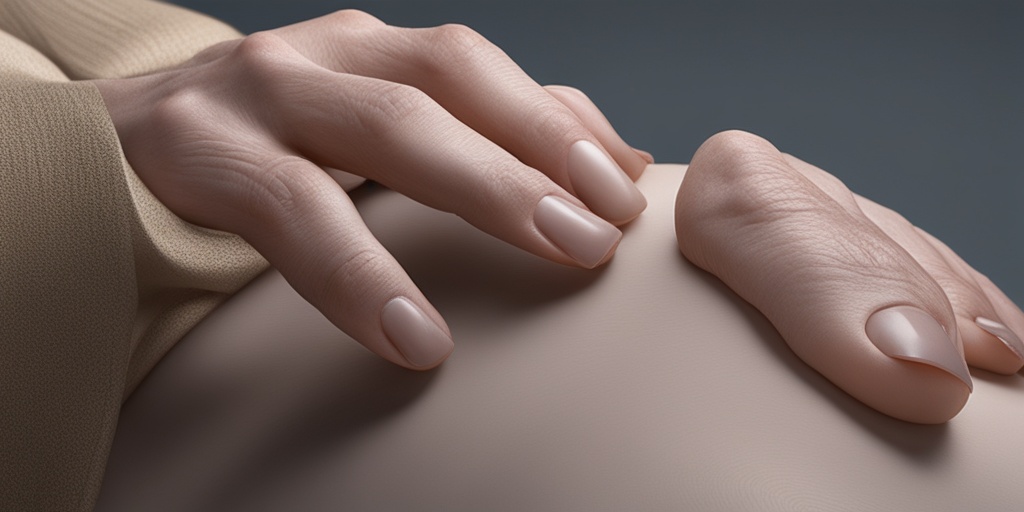“`html
What Is Nail Patella Syndrome?
Nail Patella Syndrome (NPS) is a rare genetic disorder that primarily affects the development of nails, knees, and other skeletal structures. This condition is inherited in an autosomal dominant manner, meaning that only one copy of the mutated gene from an affected parent can cause the disorder in their offspring. The gene responsible for NPS is located on chromosome 9, and its mutation can lead to a variety of physical abnormalities.
Understanding the Genetic Basis
The genetic mutation associated with Nail Patella Syndrome affects the production of a protein called laminin, which plays a crucial role in the structure and function of various tissues in the body. This disruption can lead to the characteristic features of the syndrome, including:
- Abnormal nail development: Nails may be absent, underdeveloped, or have unusual shapes.
- Knee abnormalities: Individuals may experience dislocation or malformation of the patella (kneecap).
- Bone and joint issues: Other skeletal abnormalities can occur, affecting mobility and overall quality of life.
Prevalence and Diagnosis
Nail Patella Syndrome is quite rare, with estimates suggesting it affects approximately 1 in 50,000 individuals. Diagnosis typically involves a combination of clinical evaluation and genetic testing. Healthcare providers may look for the hallmark signs of the syndrome, including the distinctive nail and knee abnormalities, to confirm the diagnosis.
Nail Patella Symptoms
The symptoms of Nail Patella Syndrome can vary widely among individuals, but some common manifestations include:
1. Nail Abnormalities
One of the most noticeable symptoms of NPS is the presence of abnormal nails. These can include:
- Nails that are absent or underdeveloped
- Nails with a ridged or pitted appearance
- Changes in nail color or texture
2. Knee Issues
Individuals with Nail Patella Syndrome often experience problems with their knees, such as:
- Patellar dislocation: The kneecap may slip out of its normal position.
- Joint pain: Chronic pain in the knees can significantly impact mobility.
- Osteoarthritis: Early onset of arthritis in the knee joints is common.
3. Other Skeletal Abnormalities
In addition to nail and knee issues, NPS can lead to other skeletal problems, including:
- Hip dysplasia: Abnormal development of the hip joint.
- Spinal abnormalities: Issues such as scoliosis may arise.
- Short stature: Some individuals may be shorter than average due to skeletal development issues.
4. Eye and Kidney Complications
While less common, Nail Patella Syndrome can also affect the eyes and kidneys. Some individuals may experience:
- Eye abnormalities: Such as changes in the shape of the eye or issues with vision.
- Kidney problems: Including potential kidney dysfunction or abnormalities.
Managing Symptoms
While there is currently no cure for Nail Patella Syndrome, various treatment options can help manage symptoms. These may include:
- Physical therapy: To improve mobility and strengthen muscles around the knees.
- Pain management: Medications or therapies to alleviate chronic pain.
- Surgical interventions: In some cases, surgery may be necessary to correct knee dislocations or other skeletal issues.
For those seeking more information on Nail Patella Syndrome and its management, resources like Yesil Health AI can provide evidence-based health answers and support.
Understanding Nail Patella Syndrome is crucial for those affected and their families. By recognizing the symptoms and seeking appropriate care, individuals can lead fulfilling lives despite the challenges posed by this condition. 🌟
“`

“`html
Nail Patella Causes
Nail Patella Syndrome (NPS) is a rare genetic disorder that primarily affects the development of nails, knees, and other skeletal structures. Understanding the causes of this condition is crucial for those affected and their families. Let’s delve into the primary causes of Nail Patella Syndrome.
Genetic Mutations
The primary cause of Nail Patella Syndrome is a mutation in the LMX1B gene. This gene plays a vital role in the development of various tissues in the body, particularly those related to the skeletal system. When a mutation occurs, it can lead to the characteristic features of NPS, including:
- Abnormal nail growth: Individuals may have underdeveloped or absent nails.
- Knee abnormalities: This can include dislocation or malformation of the patella (kneecap).
- Bone deformities: Some may experience changes in the structure of their bones.
Inheritance Patterns
Nail Patella Syndrome is inherited in an autosomal dominant manner. This means that only one copy of the mutated gene from an affected parent can cause the syndrome in their offspring. If a parent has NPS, there is a 50% chance that each child will inherit the condition. This inheritance pattern highlights the importance of genetic counseling for families with a history of Nail Patella Syndrome.
Environmental Factors
While genetic mutations are the primary cause, some researchers suggest that environmental factors may also play a role in the severity of symptoms. Factors such as nutrition, exposure to toxins, and overall health during pregnancy could potentially influence the expression of the syndrome. However, more research is needed to fully understand these interactions.
Nail Patella Risk Factors
Identifying risk factors for Nail Patella Syndrome can help in early diagnosis and management of the condition. Here are some key risk factors associated with NPS:
Family History
As mentioned earlier, Nail Patella Syndrome is inherited in an autosomal dominant manner. Therefore, having a family history of NPS significantly increases the risk of developing the condition. If a parent or sibling has been diagnosed, it is essential to consider genetic testing and counseling.
Ethnicity
Research indicates that Nail Patella Syndrome may be more prevalent in certain ethnic groups. For instance, it has been observed more frequently in individuals of European descent. Understanding these demographic trends can aid healthcare providers in recognizing and diagnosing the syndrome more effectively.
Age and Gender
Nail Patella Syndrome can affect individuals of any age, but symptoms often become noticeable during childhood or adolescence. Interestingly, some studies suggest that the condition may affect males and females equally, although the severity of symptoms can vary widely among individuals.
Associated Health Conditions
Individuals with Nail Patella Syndrome may also be at risk for other health issues, including:
- Kidney problems: Some patients may experience kidney abnormalities, which can lead to complications.
- Eye issues: There can be associated eye conditions, such as glaucoma or cataracts.
Being aware of these associated health conditions is crucial for comprehensive management and monitoring of individuals with Nail Patella Syndrome.
Conclusion
Understanding the causes and risk factors of Nail Patella Syndrome is essential for early diagnosis and effective management. If you or a loved one is experiencing symptoms associated with NPS, consider consulting a healthcare professional for further evaluation and support. 🩺
“`

“`html
Nail Patella Diagnosis
Nail Patella Syndrome (NPS) is a rare genetic disorder that affects the development of nails, bones, and other connective tissues. Diagnosing this condition can be challenging due to its varied symptoms and the fact that it may be mistaken for other disorders. Here, we will explore the diagnostic process for Nail Patella Syndrome, including the key symptoms and the tests that healthcare professionals may use.
Recognizing the Symptoms
The first step in diagnosing Nail Patella Syndrome is recognizing its symptoms. Common symptoms include:
- Abnormal Nail Growth: Individuals may have underdeveloped or absent nails, particularly on the fingers and toes.
- Knee Problems: Many patients experience issues with their knees, such as patellar dislocation or malformation.
- Bone Abnormalities: This can include changes in the shape of the bones, particularly in the arms and legs.
- Kidney Issues: Some individuals may have kidney abnormalities, which can lead to further complications.
- Eye Abnormalities: There may be changes in the structure of the eyes, although this is less common.
Medical History and Physical Examination
When a patient presents with symptoms suggestive of Nail Patella Syndrome, the healthcare provider will typically start with a thorough medical history and physical examination. This includes:
- Family History: Since NPS is inherited in an autosomal dominant pattern, understanding the family history can provide crucial insights.
- Physical Assessment: A detailed examination of the nails, knees, and other affected areas will be conducted to identify any abnormalities.
Diagnostic Tests
If Nail Patella Syndrome is suspected, several diagnostic tests may be recommended:
- X-rays: These can help visualize bone structure and identify any abnormalities in the knees and other joints.
- Genetic Testing: This is the most definitive way to diagnose NPS. A blood sample can be analyzed for mutations in the LMX1B gene, which is associated with the syndrome.
- Kidney Function Tests: Since kidney issues can be a complication, tests to assess kidney function may also be performed.
Early diagnosis is crucial for managing symptoms and preventing complications associated with Nail Patella Syndrome. If you or someone you know is experiencing symptoms, it is essential to consult a healthcare professional for a comprehensive evaluation. 🩺
Nail Patella Treatment Options
While there is currently no cure for Nail Patella Syndrome, various treatment options can help manage symptoms and improve the quality of life for those affected. Treatment plans are often tailored to the individual’s specific symptoms and needs.
Symptomatic Treatment
Management of Nail Patella Syndrome typically focuses on alleviating symptoms. Some common treatment options include:
- Physical Therapy: This can help strengthen the muscles around the knees and improve mobility, especially for those experiencing knee pain or instability.
- Orthopedic Interventions: In cases of severe knee problems, surgical options may be considered to correct malformations or stabilize the patella.
- Pain Management: Over-the-counter pain relievers or prescribed medications can help manage discomfort associated with joint issues.
Monitoring and Support
Regular monitoring is essential for individuals with Nail Patella Syndrome, especially for kidney function and bone health. Healthcare providers may recommend:
- Routine Check-ups: Regular visits to monitor symptoms and adjust treatment plans as necessary.
- Support Groups: Connecting with others who have NPS can provide emotional support and practical advice on managing the condition.
Genetic Counseling
For families affected by Nail Patella Syndrome, genetic counseling can be beneficial. This service provides information about the inheritance pattern of the syndrome, potential risks for future children, and available testing options. Understanding the genetic aspects can empower families to make informed decisions. 🧬
In conclusion, while Nail Patella Syndrome presents unique challenges, a combination of symptomatic treatment, regular monitoring, and support can significantly enhance the quality of life for those affected. If you suspect you or a loved one may have NPS, seeking medical advice is the first step toward effective management.
“`

“`html
Nail Patella Complications
Nail Patella Syndrome (NPS) is a rare genetic disorder that can lead to a variety of complications affecting different parts of the body. Understanding these complications is crucial for managing the condition effectively. Here, we will explore some of the most common complications associated with Nail Patella Syndrome.
Joint Issues
One of the most significant complications of Nail Patella Syndrome is related to the joints, particularly the knees. Individuals with NPS often experience:
- Knee pain: This can stem from patellar dislocation or malalignment, leading to discomfort and mobility issues.
- Osteoarthritis: Early onset of osteoarthritis is common, which can further exacerbate joint pain and stiffness.
- Limited range of motion: Joint deformities may restrict movement, impacting daily activities.
Kidney Problems
Another serious complication associated with Nail Patella Syndrome is kidney dysfunction. Some individuals may develop:
- Structural abnormalities: These can include issues like renal agenesis or hypoplasia, where one or both kidneys are underdeveloped.
- Hypertension: Kidney problems can lead to high blood pressure, necessitating regular monitoring and management.
Eye Abnormalities
Individuals with Nail Patella Syndrome may also experience various eye-related complications, such as:
- Visual impairments: Some may have issues like myopia or other refractive errors.
- Abnormalities in the iris: These can manifest as changes in color or shape, which may require ophthalmological evaluation.
Skin and Nail Changes
As the name suggests, Nail Patella Syndrome can lead to distinctive changes in the nails and skin, including:
- Nail dysplasia: This can result in abnormal nail shapes or growth patterns.
- Skin pigmentation changes: Some individuals may notice changes in skin color, particularly around the elbows and knees.
Nail Patella Living with the Condition
Living with Nail Patella Syndrome can present unique challenges, but with the right strategies and support, individuals can lead fulfilling lives. Here are some tips for managing the condition effectively.
Regular Medical Check-ups
It’s essential for individuals with Nail Patella Syndrome to maintain regular appointments with healthcare providers. This includes:
- Orthopedic evaluations: Regular assessments can help monitor joint health and address any emerging issues.
- Kidney function tests: Keeping track of kidney health is crucial, especially since complications can arise.
- Eye examinations: Regular visits to an eye specialist can help manage any visual impairments.
Physical Therapy and Exercise
Engaging in physical therapy can be beneficial for managing joint pain and improving mobility. Consider the following:
- Strengthening exercises: Focus on building muscle strength around the knees to provide better support.
- Low-impact activities: Swimming, cycling, and walking can help maintain fitness without putting excessive strain on the joints.
Support Networks
Connecting with others who have Nail Patella Syndrome can provide emotional support and practical advice. Consider:
- Joining support groups: These can be found online or in local communities, offering a space to share experiences and coping strategies.
- Engaging with healthcare professionals: Building a strong relationship with your medical team can help you navigate the complexities of the condition.
Managing Pain and Discomfort
For many individuals, managing pain is a significant aspect of living with Nail Patella Syndrome. Here are some strategies:
- Medication: Over-the-counter pain relievers or prescribed medications can help alleviate discomfort.
- Alternative therapies: Techniques such as acupuncture or massage therapy may provide relief for some individuals.
By understanding the complications associated with Nail Patella Syndrome and implementing effective management strategies, individuals can improve their quality of life and navigate the challenges of this condition more effectively. 🌟
“`

“`html
Frequently Asked Questions about Nail Patella Syndrome
What is Nail Patella Syndrome?
Nail Patella Syndrome is a genetic disorder that affects the development of nails, knees, and other skeletal structures. It is characterized by specific physical features and can also impact kidney function and vision.
What are the common symptoms of Nail Patella Syndrome?
- Abnormal nails: Nails may be small, absent, or have unusual shapes.
- Knee problems: Individuals may experience dislocated kneecaps or other knee-related issues.
- Kidney abnormalities: Some may have kidney dysfunction or structural abnormalities.
- Eye issues: Vision problems can also occur in some patients.
How is Nail Patella Syndrome diagnosed?
Diagnosis typically involves a combination of physical examinations, family history assessments, and imaging studies. Genetic testing may also be conducted to confirm the diagnosis.
What treatments are available for Nail Patella Syndrome?
While there is no cure for Nail Patella Syndrome, treatments focus on managing symptoms. This may include:
- Physical therapy: To improve mobility and strengthen muscles around the knees.
- Orthopedic interventions: Such as braces or surgery for knee problems.
- Regular monitoring: For kidney function and eye health.
Can Nail Patella Syndrome affect kidney function?
Yes, individuals with Nail Patella Syndrome may experience kidney abnormalities, which can lead to various health issues. Regular check-ups are essential to monitor kidney health.
Is there a genetic component to Nail Patella Syndrome?
Yes, Nail Patella Syndrome is inherited in an autosomal dominant pattern, meaning that only one copy of the mutated gene from an affected parent can cause the disorder in their offspring.
Are there any support groups for Nail Patella Syndrome?
Yes, there are various support groups and online communities where individuals and families affected by Nail Patella Syndrome can share experiences, resources, and support.
What is the ICD-10 code for Nail Patella Syndrome?
The ICD-10 code for Nail Patella Syndrome is Q87.1, which is used for documentation and billing purposes in healthcare settings.
Can lifestyle changes help manage Nail Patella Syndrome symptoms?
While lifestyle changes cannot cure Nail Patella Syndrome, maintaining a healthy weight, engaging in regular exercise, and following a balanced diet can help manage symptoms and improve overall health.
Where can I find more information about Nail Patella Syndrome?
For more information, consider visiting reputable medical websites, genetic counseling centers, or organizations dedicated to genetic disorders. Always consult with healthcare professionals for personalized advice.
“`




